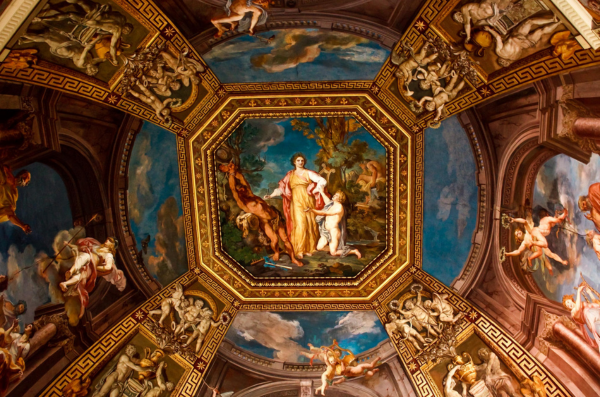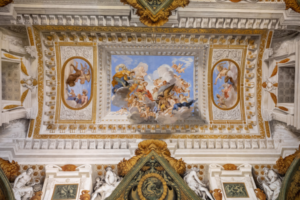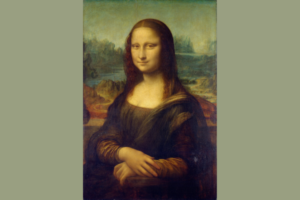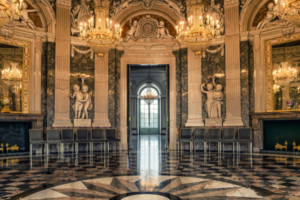A brief historical context of the period preceding the Renaissance.
In the very heart of Europe, during the transition between the Middle Ages and the Modern Age, a movement took shape that would redefine the continent and, subsequently, the world: The Renaissance. However, to grasp its magnitude, it’s essential to step back and position oneself in the final chapters of the Middle Ages.
The centuries leading up to the Renaissance were marked by profound transformations: the Crusades reopened trade routes with the East, the Black Plague decimated entire populations, and the fall of the Western Roman Empire had left a power vacuum. Europe, at that time, was a fragmented tapestry of fiefdoms, kingdoms, and city-states in constant conflict, while the Catholic Church wielded strong dominion over the continent’s spiritual and intellectual life.
The significance of Italy as the cradle of the Renaissance.
Within this backdrop, Italy emerged as an epicenter of change. Unlike other regions of Europe, Italy did not consolidate into a unified kingdom but rather into various city-states, such as Florence, Venice, and Milan. These cities, wealthy and powerful due to trade and industry, became cradles of innovation and thought. It was fertile ground where the seeds of the Renaissance could sprout and blossom.
Therefore, when speaking of the Renaissance, Italy is not merely a backdrop, but the pulsating heart of a movement that esteemed the individual, art, science, and the relentless pursuit of knowledge. The rediscovery of Greek and Roman classics, the valorization of humanism, and a new worldview centered on the human being began to bloom in Italian streets, squares, and palaces, casting their light on a Europe ready to awaken.
This awakening, with its epicenter in Italy, marked the onset of an era where man began to see himself not just as a mere spectator, but as the protagonist of his own story, heralding the period we now recognize as the Italian Renaissance.
What was the Italian Renaissance?
Definition and characterization of the period
The Italian Renaissance was a cultural, artistic, and intellectual movement that originated in Italy in the late 14th century and extended into the 17th century. This period marked the end of the Middle Ages and the transition to the Modern Age. At its core, the Renaissance was a “rebirth”, a profound renewal and a return to the classical ideas and aesthetics of ancient Greece and Rome, marked by an explosion of creativity, new approaches to art, and a humanistic view of the world.
Unlike medieval times, where life and knowledge were rigidly centered around the Church and spirituality, the Italian Renaissance was characterized by a focus on the individual and the natural world. Artists, writers, and scientists now studied the world through direct observation and experience, and their art and literature reflected a deep interest in the human condition.
Highlight of the main city-states involved
Principal City-States
Florence
Regarded as the cradle of the Renaissance, Florence was the city where this movement reached its fullness earliest. Under the patronage of the powerful Medici family, the city became a magnet for artists and intellectuals. It was in Florence that Leonardo da Vinci, Michelangelo, and Botticelli crafted some of their most iconic works.
Rome
Rebuilt and glorified during the Renaissance, Rome transformed into a major center for art and culture, thanks to the support of the popes, who, like the Medici in Florence, acted as patrons of the arts. The city attracted artists from all over Italy and Europe, including Michelangelo, who painted the Sistine Chapel during this period.
Venice
Known as the Serene Republic, Venice was a vital trade center and maritime leader. The city developed a unique Renaissance style, with artists like Titian and Tintoretto producing works that were richer in color and more fluid in composition than those found elsewhere in Italy.
Milan, Naples, and other cities:
Other city-states, like Milan and Naples, also played significant roles as centers of art and learning. Each of these cities contributed uniquely to the movement, developing distinct styles and hosting renowned artists.
In summary, the Italian Renaissance was an era of unprecedented cultural revival. It was a period where art, science, and human thought intertwined in new and revolutionary ways, and Italy, with its prosperous and competitive city-states, was at the forefront of this transformation that would resonate for centuries.
Factors that Drove the Italian Renaissance
The rise of the Italian Renaissance was not an isolated event. Like every major cultural movement, it was the outcome of a blend of socioeconomic, political, and cultural factors that interwove uniquely in Italy at the end of the Middle Ages and the start of the Modern era. Let’s delve into the primary drivers that breathed life into this revolutionary period.
Fall of the Byzantine Empire and the arrival of scholars on Italian soil:
With the fall of Constantinople in 1453 into Ottoman hands, what remained of the ancient Eastern Roman Empire, or Byzantine Empire, came to its end. This cataclysmic event led many Byzantine scholars, bearers of ancient Greek and Roman classical texts, to flee to the West. Italy, particularly the city of Florence, became a haven for these intellectuals. They brought with them vast knowledge, reintroducing to Western Europe many texts that had been forgotten during the Middle Ages. This ignited a renewed interest in classical learning, providing a solid foundation for Renaissance humanism.
Commercial and banking developments, especially in Florence:
The late Middle Ages saw a boom in transalpine and maritime trade. Italy, due to its strategic position in the Mediterranean, was ideally placed to benefit from these trade routes. Cities like Florence quickly became hubs of commerce and finance. Florentine bankers, like the Medici family, amassed immense wealth and established banking networks spanning across Europe. This steady flow of capital not only elevated Florence’s status as an economic powerhouse but also provided the means to fund a broad range of artistic and cultural ventures.
The influence of patrons and their role in funding the arts:
Patrons played a pivotal role in the flowering of the arts during the Renaissance. These wealthy patrons, often members of the nobility or religious leaders, funded artists, writers, and scholars, providing them with the means to devote themselves to their craft. Lorenzo de Medici, for instance, was one of the foremost patrons of his time, supporting artists like Botticelli and Michelangelo. These patrons funded the arts not merely for aesthetic pleasure but also to assert their status, power, and prestige. Art, in this context, became a tangible symbol of a family’s or institution’s wealth and influence.
Together, these factors created an environment where innovation and experimentation were encouraged and cherished. The confluence of classical wisdom with capital and the backing of dedicated patrons resulted in one of the most fertile and transformative periods in human history. Italy, with its rich tapestry of city-states and its strategic position at the crossroads of Europe, was perfectly poised to lead this cultural revolution.
Key Personalities and Their Contributions
The Italian Renaissance was a movement illuminated by some of the brightest minds in human history. These visionaries, through their works and innovations, shaped not only their own time but also left a lasting legacy that resonates to this day. Here, we highlight some of these central figures and their invaluable contributions:
Leonardo da Vinci
The archetype of the “Renaissance man”, Leonardo da Vinci was a true polymath, excelling in fields as diverse as art, science, anatomy, and engineering. Beyond his famous paintings, such as the “Mona Lisa” and “The Last Supper”, da Vinci filled notebooks with sketches and notes that revealed an insatiable curiosity about the world. His studies on flight, bodies of water, and human anatomy were profoundly innovative for his time, many of which were ahead of their era.
Michelangelo
If da Vinci was the mind of the Renaissance, Michelangelo was unquestionably its soul. His talents manifested across various art forms, from sculpture to painting. His magnum opus, the ceiling of the Sistine Chapel in the Vatican, is a vivid portrayal of Genesis and continues to leave visitors from around the world awestruck. Additionally, his sculptures, like “David” and “The Pieta”, display a deep and sensitive understanding of the human form, elevating sculpture to new heights.
Raphael Sanzio
Raphael, often placed alongside da Vinci and Michelangelo, is celebrated for his ability to infuse harmony, balance, and serenity into his paintings. His most notable talent was his capability to capture both humanity and divinity simultaneously. “The School of Athens”, for instance, painted in the Vatican chambers, is a celebration of classical thought and depicts the greatest philosophers of Ancient Greece in a harmonious composition.
Dante Alighieri
Though Dante lived before the height of the Renaissance, his influence permeated the entire period. His most renowned work, “The Divine Comedy”, is an epic journey through Hell, Purgatory, and Paradise. Beyond its notable literary and theological quality, Dante’s work helped establish Tuscan as the standard literary language of Italy and remains one of the greatest achievements in world literature.
Among others
Naturally, this was just a period of extraordinary cultural effervescence, and many other artists and intellectuals, such as Botticelli, Donatello, Galileo, and Petrarch, also made significant contributions. Each, in their own way, helped shape the Italian Renaissance and define the course of subsequent European history.
Through the work and genius of these individuals, the Italian Renaissance became one of the most fruitful and influential periods in the history of art and thought, whose impact continues to be felt and celebrated worldwide.
Artistic and Technical Innovations of the Period
The Italian Renaissance was not just a time of artistic and intellectual flowering; it was also an era of technical and methodological innovation. These new techniques allowed artists to depict the world and human experience with unprecedented precision and depth. Here, we explore some of the most significant artistic and technical innovations that defined Renaissance art:
Linear Perspective
Before the Renaissance, artistic representations were often flat and lacked depth. The innovation of linear perspective revolutionized how space was depicted on canvas. This technique used converging lines that met at a vanishing point, creating a convincing illusion of depth and three-dimensionality. Through linear perspective, artists could create more realistic and immersive compositions, drawing the viewer into the depicted scene.
Realism and Attention to Human Detail
The Renaissance saw a dramatic shift in how humans were portrayed. Instead of idealized and stylized figures, artists began to depict people with individual and realistic features, often based on detailed studies of anatomy. Sculpture, in particular, became a way to celebrate the beauty and complexity of the human body in all its nuances.
Renewed Use of Light and Shadow (Chiaroscuro)
Chiaroscuro, or “light-dark”, refers to the technique of using strong contrasts between light and shadow to give volume and depth to objects and figures. Artists like Leonardo da Vinci and Caravaggio mastered this technique, employing it to impart a tangible sense of three-dimensionality to their works and to guide the viewer’s gaze through the composition.
Humanism: Man at the Center of the Universe
More than just a technique, humanism was a philosophy that placed the human being at the center of experience and understanding. Contrasting with the medieval view, which often placed the divine and the beyond as the central focus, the Renaissance embraced the idea that the human being, with all its virtues and flaws, was worthy of celebration and study. This humanist ethos was reflected in all art forms, from paintings to sculptures and literary texts, often highlighting the individual and their relationship with the world.
These innovations not only defined Renaissance art but also laid the groundwork for subsequent artistic development, influencing generations of artists and continuing to inform our understanding and appreciation of art to this day.
The Renaissance Beyond the Arts: Science and Philosophy
While the Renaissance is often associated with the flourishing of the arts, this movement was equally vibrant and revolutionary in the realm of science and philosophy. Just as artists were seeking new ways to express and understand the human experience, the scientists and philosophers of the time were breaking the shackles of medieval thought, embracing a more empirical and rational approach to unraveling the mysteries of the world.
The Scientific Method and the Quest for Understanding the World
Before the Renaissance, understanding of the natural world was often mediated by religious dogma and ancient traditions. The Renaissance brought with it a renewed emphasis on direct observation and experimentation – the cornerstones of the modern scientific method. Rather than passively accepting established truths, Renaissance scientists adopted a critical stance, questioning, testing, and validating theories through empirical evidence.
Luminaries like Galileo Galilei and his Astronomical Studies
Galileo, often referred to as the “father of modern science”, is a prime example of the inquisitive spirit of the era. With his telescope, he observed the heavens and made discoveries that challenged traditional views of the cosmos. He noted mountains and craters on the Moon, identified four of Jupiter’s moons, and observed the phases of Venus, providing crucial evidence in support of Copernicus’s heliocentric theory. However, these discoveries put him at odds with the Church, exemplifying the tension between scientific advancement and religious authority during the Renaissance.
The Revolution in Philosophy and the Return to the Greek and Roman Classics
The Renaissance humanism was not confined to the arts; it also permeated the field of philosophy. Renaissance thinkers eagerly returned to the texts of Greek and Roman philosophers, seeking inspiration from Plato, Aristotle, Epicurus, and others. They believed that by rediscovering classical thought, they could attain a deeper understanding of human experience and nature. Thinkers like Erasmus of Rotterdam, Pico della Mirandola, and Marsilio Ficino deeply engaged with these ancient texts, generating new syntheses and ideas that continue to influence modern philosophy.
Thus, the Renaissance, with its renewed focus on the individual and empirical experience, not only transformed the arts but also paved the way for the scientific revolution and new modes of philosophical thought, which continue to shape the world today.
The Cultural Impact and Its Influence Beyond Italy
While Italy was undeniably the cradle of the Renaissance, the ideas and innovations of this flourishing cultural movement did not remain confined within its borders. In a world increasingly interconnected by trade, politics, and religion, the Italian Renaissance sent ripples throughout the European continent, leading to new cultural flowerings and variations of the original movement.
The Spread of Renaissance Ideas to Other Parts of Europe
The expansion of the Renaissance beyond Italy was driven by various factors. Frequent wars and diplomacy resulted in an exchange of ideas and cultures. Moreover, the advent of Gutenberg’s printing press in the mid-15th century played a crucial role, making texts and ideas more accessible and widespread across Europe. Many Italian artists and scholars also traveled or were hired in foreign courts, carrying with them Renaissance techniques and styles.
The Northern European Renaissance: Differences and Similarities to the Italian
While the Italian Renaissance was rooted in city-states and the classics of antiquity, the Northern European Renaissance, flourishing in places like Flanders, France, Germany, and England, had its own unique characteristics and emphases.
Similarities: Just like in Italy, there was a renewed emphasis on the individual, realism in art, and the exploration of human capabilities and potential. Techniques like linear perspective and chiaroscuro were equally popular, and there was a return to the study of classical texts.
Differences: The art of the Northern European Renaissance tended to be more detailed, with a particular focus on the meticulous representation of natural details, such as flora and textures. While Catholicism dominated Italy, Northern Europe witnessed the rise of Protestantism, which influenced the themes and nature of the art produced. For instance, while Italy continued producing many grand religious-themed works, the northern countries saw an uptick in the production of portraits and genre scenes, often on a smaller scale.
In summary, although the Renaissance had its roots in Italy, its influence spread across the continent, adapting and evolving in line with local and cultural conditions. This exchange and interaction between regions further enriched the Renaissance legacy, leaving an indelible mark on Europe’s cultural tapestry.
Decline and Legacy of the Italian Renaissance
The Italian Renaissance, with its burst of creativity and innovation, was not an everlasting phenomenon. Like all golden ages, it had its sunset. However, even after its decline, the legacy of the Renaissance continued to resonate, deeply influencing the evolution of thought, art, and science in the subsequent centuries.
Causes for the end of this period of artistic and intellectual blossoming
Invasions and Political Instabilities: Late 15th and early 16th-century Italy was a battleground for invasions and territorial disputes, mainly by the French and Spanish forces. These incursions brought destruction and instability, shifting the center of power and influence to other parts of Europe.
Rise of the Baroque: In the art world, new styles began to emerge, offering a reaction or evolution to the Renaissance. The Baroque style, for instance, with its emphasis on drama, emotion, and ornamentation, began to take prominence.
Counter-Reformation: The Catholic Church’s response to the Protestant Reformation, known as the Counter-Reformation, had a profound impact on culture and art. This religious reaction brought with it a suppression of some forms of artistic and intellectual expression and a new direction for the arts, which became more overtly focused on religiosity and devotion.
Economic Center Shift: The economic center started moving towards Northern Europe, particularly the Low Countries and England, leading to a migration of artists and intellectuals seeking patrons and opportunities.
How the Renaissance shaped modern thought and influenced subsequent periods
Foundation of Modern Science: The Renaissance emphasis on observation, experimentation, and rationality laid the groundwork for the development of the scientific method, which would become crucial for scientific advancements in the following centuries.
Humanism and Enlightenment: The Renaissance’s focus on the individual and humanism provided a foundation for the Enlightenment thinkers of the 18th century, who championed reason, freedom, and individual rights.
Art and Architecture: Renaissance artistic principles, such as linear perspective and realism, continued to influence artists in later eras. Additionally, the study and imitation of classical forms became fundamental to artistic education.
Literature: Major Renaissance works, like Dante’s “Divine Comedy” and Petrarch’s sonnets, influenced generations of writers and poets, shaping literary conventions and styles.
In conclusion, though the Italian Renaissance eventually declined, its influence was profound and enduring. Its ideals and innovations permeated almost every aspect of society and culture, helping to shape the modern world as we know it today.
Conclusion
The Italian Renaissance is, without a doubt, one of the most significant and influential periods in the tapestry of human history. It was a time of renewal, of a return to classical roots, and most importantly, of a refocusing on the potential and capacities of the individual. The explosion of creativity, innovation, and critical thinking during this era not only transformed Italy but also sent waves of change throughout the world, shaping the trajectory of Western civilization.
Revisiting the Italian Renaissance is not just an academic journey or an aesthetic appreciation; it’s a deep exploration into the evolution of human thought. It is witnessing the moment when humanity began to see itself differently, to recognize its abilities to transform the world around it, and to seek a deeper understanding of its position in the cosmos. This period reminds us of the power of curiosity, the passion for learning, and the importance of freedom of expression.
Moreover, in a world that sometimes seems to be in constant change and turmoil, looking back at the Renaissance offers a comforting perspective. Just as Italy emerged from times of darkness and instability to birth an era of enlightenment and innovation, we too can find inspiration in our own capacity for renewal and resilience.
Ultimately, the legacy of the Italian Renaissance serves as a beacon, illuminating the rich tapestry of our collective history and encouraging us to pursue excellence, understanding, and innovation in all our endeavors. And perhaps most importantly, it reminds us of the invaluable worth of each individual, of every person’s ability to contribute to the greater good, and to shape the course of history.



